Sour cherries in Canada
Archived Content
Information identified as archived is provided for reference, research or recordkeeping purposes. It is not subject to the Government of Canada Web Standards and has not been altered or updated since it was archived. Please "contact us" to request a format other than those available.
by Adrienne Montgomery, Statistics Canada
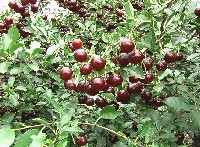 Historically there have been two main types of cherries: sweet cherries, which we eat fresh from the tree and farmers' markets in the summer, and sour cherries, which we find in a variety of processed forms. Sour cherries (known as "tart cherries" in the United States), are aptly named compared to regular sweet cherries. They make up the majority of the processed cherries we consume, from pie fillings to dried cherries, cherry preserves and cherry juice. Compared to sweet cherries, they tend to hold their shape and texture better in cooking, and their tartness mellows into a deep, sweet flavour making them highly prized for all processed cherry products.
Historically there have been two main types of cherries: sweet cherries, which we eat fresh from the tree and farmers' markets in the summer, and sour cherries, which we find in a variety of processed forms. Sour cherries (known as "tart cherries" in the United States), are aptly named compared to regular sweet cherries. They make up the majority of the processed cherries we consume, from pie fillings to dried cherries, cherry preserves and cherry juice. Compared to sweet cherries, they tend to hold their shape and texture better in cooking, and their tartness mellows into a deep, sweet flavour making them highly prized for all processed cherry products.
Canadian plant breeders have been working to produce a third type of cherry, one that combines the best traits of both sweet and sour cherries. These new sour cherry varieties are not only suited specifically to colder regions of Canada's climate, but have a sweetness and bright colour that differ from conventional sour cherries. The new dwarf sour cherries have many advantages, from their cold-hardiness, which allows them to survive cold Canadian winters, to the short stature of the bush, making them easy and economical to harvest.
This article's focus is on the development of the sour cherry in Canada. Though sweet cherry cultivation is also increasing in Canada, they are considered a separate commodity since they are a fresh seasonal product that grows in different climatic regions than the sour cherry. (See "Sweet cherries.")
Grown the world over
Worldwide, a total of 214,000 hectares of sour cherries were reported in 30 countries in 2006. World production of sour cherries has been relatively stable over the last decade, at 1.1 million tonnes in 2006—a figure consistent with the 1997 to 2006 production average. Russia is generally the world's top producer of sour cherries, with an average annual production of 177,600 tonnes between 1997 and 2006, or about 16% of the world's total harvest.
Table 1
Production by the world's top five sour cherry-producing countries and Canada, average 1997 to 2006
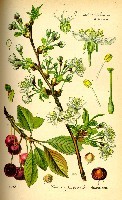 Cherries were brought to North America by English settlers. Sour cherries in particular became established in the Great Lakes region, where they grew well in the humid, moderate conditions.
Cherries were brought to North America by English settlers. Sour cherries in particular became established in the Great Lakes region, where they grew well in the humid, moderate conditions.
Canada has traditionally been a small player in the sour cherry market, representing less than half a percent of the world's production in 2006 and ranking 23rd among the 32 countries producing the crop that year. Canada is still a net importer, exporting only $3.7 million worth of sour cherries in 2007 but importing $14.3 million. In terms of value, over half our exports go to the United States, with smaller amounts going to Russia and Germany. Over three-quarters of imported sour cherries come from the United States, with smaller quantities arriving from a variety of countries including Poland, Bulgaria and Italy.
Increasing sour cherry production in Canada
Sour cherries are produced mainly in the northern hemisphere, as they tend to be relatively hardy, growing in regions with milder summers and cooler winters than sweet cherries can tolerate. Increasing Canadian interest in developing alternative varieties of sour cherries even more suited to our climate and production capacity has contributed to increases in area reported on the 2006 Census of Agriculture, particularly in the Prairies, which have not traditionally been considered prime fruit-growing regions.
On the 2006 Census of Agriculture, Canadian farmers reported 1,225 hectares of sour cherries, up 11% from 2001 (Table 2). Ontario has traditionally been Canada's sour cherry-producing region and the province still has the majority of land devoted to the crop—84% of the country's total sour cherry area. Ontario's 2006 sour cherry area was higher than in the previous three censuses, but it still has not returned to the levels of the 1970s and 1980s. The pale-fleshed Montmorency is the standard commercially grown sour cherry variety in Ontario as are over 95% of all sour cherries on the market in North America.
Sour cherry production in the Prairies is a relatively recent development and area devoted to the crop is still relatively small—though this is changing. The number of operations reporting the crop on the Prairies has more than tripled in 10 years, climbing from 47 operations in 1996 to 155 in 2006. Over the same period the area devoted to sour cherries in the three Prairie provinces climbed from 15 hectares to 109 hectares.
Cherry varieties for a cold country: a sweet story for a sour cherry
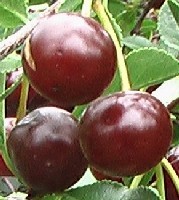 Research and development of sour cherry varieties for cultivation in Canada's cold climate began in the 1940s when Dr. Les Kerr from Agriculture Canada began crossing cherry varieties. Eventually, he bred a cherry known as the Mongolian cherry. This cherry variety was hardy, but its fruit was very tiny and extremely sour.
Research and development of sour cherry varieties for cultivation in Canada's cold climate began in the 1940s when Dr. Les Kerr from Agriculture Canada began crossing cherry varieties. Eventually, he bred a cherry known as the Mongolian cherry. This cherry variety was hardy, but its fruit was very tiny and extremely sour.
In the 1970's, the University of Saskatchewan began evaluating Mongolian cherries from Siberian Botanical Gardens. In the 1980s, Rick Sawatzky and Dr. Cecil Stushnoff began crossing Sour Cherry varieties from Northern Europe and the US with Siberian and Kerr's cherries. The resulting cherry bushes were hardy, dwarf hybrids that produced high-quality fruit. The first cultivar was released in 1999 named SK Carmine Jewel for its dark red colour. Dr. Bob Bors became the head of the program in 1999. He, along with Rick Sawatzky, increased the scale of breeding of sour cherries, developed tissue culture propagation and began research that culminated in the writing of a grower's manual and the release of the Romance Series of 5 new cherry varieties in 2005.
Since then, University of Saskatchewan breeders have produced a number of dwarf sour cherry bush varieties, bred for hardiness, short stature and high quality fruit, with the strong sweet and sour taste that has become their defining trait. While most sour cherries are ranked at a sweetness level of 10 to 16 on the Brix Scale, a sweetness gauge that measures the number of grams of sugar per 100 grams of juice, the University of Saskatchewan cherries have scored over 20. This is not only a result of breeding, but also climatic conditions: cool nights and long, sunny days often lead to high sugar content in fruit.
Unlike conventional sour cherries such as the Montmorency cherry, which are too sour for most people to enjoy fresh, the Canadian-bred sour cherries can be marketed as good for eating fresh as well as for canning, freezing and juicing. The ability to withstand -40oC winters in the Prairies also makes them an option for a greater number of Canadian growers.
The mechanical advantage
A principal advantage for growers of the new dwarf varieties is that they were developed to be machine-harvestable. Small, over-the-row harvesters used for saskatoon berries and other bush plants can be driven right over the rows of dwarf cherries. In Saskatchewan almost two-thirds of farms reporting sour cherries also reported growing saskatoon berries.
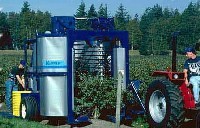 Farmers growing the taller tree varieties of sour cherries such as the Montmorency require a more complex mechanical harvesting process. These trees require specialized hydraulic equipment to shake the trees and remove the cherries. This is expensive equipment but the tree branches are so thick that hand-shaking is not an option. Most cherry orchards must be on a scale large enough to justify the investment in harvesting equipment.
Farmers growing the taller tree varieties of sour cherries such as the Montmorency require a more complex mechanical harvesting process. These trees require specialized hydraulic equipment to shake the trees and remove the cherries. This is expensive equipment but the tree branches are so thick that hand-shaking is not an option. Most cherry orchards must be on a scale large enough to justify the investment in harvesting equipment.
The only alternative to mechanical harvesting is to hire labourers to hand-pick the cherries from ladders. In developed nations such as Canada, high labour costs can add a substantial amount to production costs. It can be particularly difficult to source labour for fruit, which is highly weather-dependent and has a short window for picking. The ability to work with a crop suited to mechanization is a boon for farmers.
The challenges of an emerging sector
With the first of Saskatchewan's new sour cherries about to turn 20 years old, this new industry is still in its early stages of growth. Trees take about four to six years to mature and produce fruit, and the first commercial plantings are just now coming into their full capacity.
Up to now farmers have been harvesting and pitting their own cherries and, for the most part, selling them locally. Saskatchewan restaurants have begun to feature sour cherries on their menus as a new local specialty. Small Prairie businesses feature sour cherry ice cream, wine, chocolates and dried sour cherries in a number of products.
Producers, however, are starting to plan for the time when production levels truly start to increase. As total production exceeds demand at the local level, producers and marketing groups will have to be able to guarantee the quantity and quality required to meet the standards for larger markets. Supplying Canadian grocery stores and the export market has potential for sour cherry growers on the Prairies, as long as they are able to satisfy these more complex trading relationships.
Cherries on top
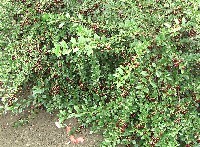 Farmers and plant breeders are experimenting with new crops for Canadian and foreign consumers. The partnership between universities, farmers and marketers promises to help Canada position itself well in new markets.
Farmers and plant breeders are experimenting with new crops for Canadian and foreign consumers. The partnership between universities, farmers and marketers promises to help Canada position itself well in new markets.
Red and blue
The sour cherries being bred in the Canadian Prairies are poised to continue the trend so well illustrated by the growth of the blueberry market. Blueberries have shown the considerable potential of these niche markets and that consumers are hungry for healthy Canadian fruit. The breeding behind these cherries has ensured winter hardiness while making them the sweetest of the sour cherries. Their short stature will ensure that harvesting remains cost-effective and simple. Sour cherries demonstrate the new direction that farmers and plant breeders are taking to keep Canada as a competitive fruit-producing country.
Green thumb, red fruit
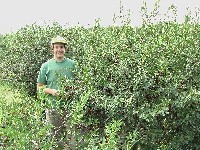 Would you like to try your hand at growing your own dwarf sour cherry bush? Suitable for growing in most climate regions in Canada, the dwarf sour cherry is an attractive hedge or ornamental bush, not to mention having the added benefit of loads of wonderful cherries that appear in the summer.
Would you like to try your hand at growing your own dwarf sour cherry bush? Suitable for growing in most climate regions in Canada, the dwarf sour cherry is an attractive hedge or ornamental bush, not to mention having the added benefit of loads of wonderful cherries that appear in the summer.
But you'll need to be patient—sour cherries often do not produce fruit until their fourth year and are generally not considered "producing" until their seventh year. They reach peak production between the seventh and 15th years, after which production declines.
- To get started, plant in well-drained soil in a protected area. Sour cherries are self-pollinating and can stand alone, although bees or other pollinators are needed to transfer the pollen.
- Give each bush approximately 25 ft2 of space.
- You can use a fruit tree fertilizer when planting—although researchers and nurseries haven't found it necessary.
- Keep the bushes watered until they are established, but reduce or stop watering in the fall to encourage dormancy.
- During the early stages of growth, weed around the bushes to remove the competition from weeds or grass. Allowing the grass in the rows between bushes to grow in late summer will encourage dormancy. As the bushes age, grass that is left to grow around the trunk will encourage deeper root growth.
- Prune in late winter or early spring. Pruning in the late summer or fall will encourage late growth that could be damaged over the winter.
- Although dwarf sour cherries do not seem to have many pest problems, watch for aphids. Larger wildlife may browse on the bushes, especially the young plants. It isn't necessary to cover the bushes with a net as birds seem to find the cherries too sour for their taste.
- Harvest by hand for a single bush or, for smaller varieties, shake the bush at the trunk to knock the berries onto a tarp below. Harvest dates are usually late July to early August. The fruit will gain a great deal of sweetness if left on the tree as long as possible.
- Wash, pit and freeze the cherries immediately, as they will only last for about two days at room temperature or about two weeks at 0oC. Pit them with any common cherry pitter and then freeze them in bags or can, juice or process them for storage.
Sweet cherries
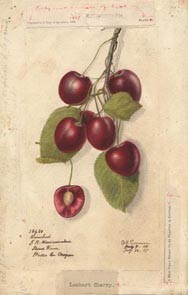 Sweet cherries, or Prunus avium, are the cherries generally sold fresh in the grocery stores in the summer. They are very much a seasonal fruit: their shelf life is often only a matter of days or a maximum of two weeks if refrigerated. Two-thirds of sweet cherry production is sold for fresh consumption, while the remaining third is processed.
Sweet cherries, or Prunus avium, are the cherries generally sold fresh in the grocery stores in the summer. They are very much a seasonal fruit: their shelf life is often only a matter of days or a maximum of two weeks if refrigerated. Two-thirds of sweet cherry production is sold for fresh consumption, while the remaining third is processed.
There were 1,720 hectares devoted to sweet cherries in Canada in 2006, up 25.6% from 1,369 hectares in 2001. Most sweet cherry production in Canada is in British Columbia, which had 75% of the area devoted to sweet cherries in 2006. Ontario had most of the rest of sweet cherry area in Canada, with 384 hectares in 2006.
Worldwide sweet cherry production has increased over the past decade, although it has varied over the years because of the weather, much like sour cherries. Demand for fresh sweet cherries continues to grow, as consumer interest in the health benefits of cherries increases. In 2006, a total of 1,872,000 kilograms of sweet cherries were produced from a harvested area of 341,000 hectares.
Other new and upcoming Canadian crops…
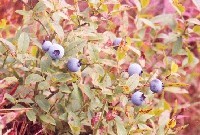 In addition to sour cherries, the growth of specialty crops such as cranberries, blueberries, saskatoon berries, and other fruit is well underway. Besides tasting good, berries and fruits are highly valued because they contain antioxidants, which may prevent cancer and heart disease. Sour cherries have been found to have antioxidant levels similar to red wine.
In addition to sour cherries, the growth of specialty crops such as cranberries, blueberries, saskatoon berries, and other fruit is well underway. Besides tasting good, berries and fruits are highly valued because they contain antioxidants, which may prevent cancer and heart disease. Sour cherries have been found to have antioxidant levels similar to red wine.
Other fruit being bred specifically for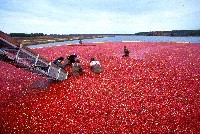 cold climates include Prairie-hardy apples, grapes and haskap berries, a blue honeyberry native to Canada and described as a cross between a currant and a blueberry. These haskap berries were formerly grown in the Hokkaido region of Japan, where they were used in teas, sweets and baked goods. Today, with the loss of agricultural land to urban development, Japan no longer has any significant cultivation of these berries, although Japanese consumers are still eager to purchase them.
cold climates include Prairie-hardy apples, grapes and haskap berries, a blue honeyberry native to Canada and described as a cross between a currant and a blueberry. These haskap berries were formerly grown in the Hokkaido region of Japan, where they were used in teas, sweets and baked goods. Today, with the loss of agricultural land to urban development, Japan no longer has any significant cultivation of these berries, although Japanese consumers are still eager to purchase them.
- Date modified:
